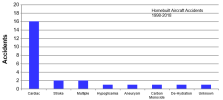That NTSB report was helpful in determining the facts of the collision. It seemed very odd that the twin’s pilot did not perform the rudiments of his landing checklist. But, a few weeks after the accident, my brother woke up with a paralyzed right arm. Being a surgeon (retired), he diagnosed his problem as a mini-stroke. He called a neurologist colleague, who gave him generic advice (Yeah, probably a stroke; these things happen to older guys; don’t panic, it’ll clear up in a bit; come in, we’ll check you out.). Turns out, things cleared up, the neurologist found some other circulation issues, no lasting damage.
But if my brother had been piloting a twin 10 miles from Watsonville, he would have spent the last few minutes of his life completely conscious, speaking normally, willing his body to do the right things, and completely unable to configure his gear, throttle, prop, and flaps for a landing. So, maybe the twin guy was a thoughtless jerk; and maybe he performed none of right pilot duties because he couldn’t.


